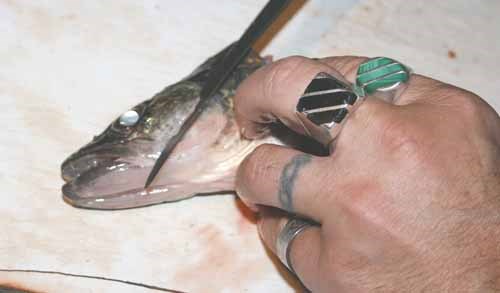This might seem like a strange statement, but one of the most useful tools for a fisherman is his laptop with access to the Internet.
No I don't mean you should cart your laptop to the lakeshore. After all one false step and it would be so much sparking flotsam until it slipped under the surface.
But on days when you have to work, you can spend your coffee breaks doing some very useful web surfing.
It can be an excellent place to check out different lines of lures, new fish attractants and the latest rods and reels.
It is also a great place to check out recipes, as was the case when I was looking for brines for smoked pike, and just what to do when it came to pickling pike.
It was on one of those searches, the kind where you are looking for nothing in particular, and follow one link to another to another, that I read about pickerel cheeks as the best part of the fish.
At first I thought it was some kind of joke. I've caught a fair number of walleye (pickerel) in my day and I can't ever recall looking at the face of one and thinking 'oh yes those cheeks would be a tasty treat'.
So I read farther, and found report after report which reaffirmed the original webpage, that pickerel cheeks are tasty.
Then the question became how does one harvest a pickerel cheek?
That is where YouTube.com came in very handy. It's a site with videos on just about everything you can imagine in terms of 'how-to', and yes that included how to cut out a pickerel's cheek.
It's actually quite easy.
If you push on the cheek, the area just below the eye, you can feel the small medallion-sized piece of meat.
Slip the point of a sharp fishing knife in just under the eye, and then going around in a circle that is about the size of a silver dollar.
You end up with a little medallion of flesh that once you cut the skin off, you can they cook up and enjoy.
Now you're only getting a morsel, but some of the best taste experiences come with small portions.
My first experience in 'cheeking' came on three pickerel under the slot limit at the new Togo
Bridge. That means the fish were all under 45-centimetres, so the cheeks were not large, but they cut out pretty slick.
The next step was cooking the cheeks.
Online some suggest deep frying, but I opted for a quick fry in a bit of butter, with just a dash of minced garlic.
Now I am not sure what I expected, although there were lots of rave reviews and comment online regarding the cheeks.
They have a different texture from the rest of the pickerel, and a milder flavour, one which really ended up being that of butter and garlic. In that respect I can see the comparison some made to lobster. Without the hot butter and garlic lobster is kind of a tasteless, bottom feeding, sea critter.
The cheeks are certainly OK, and since they are easy enough to harvest, they are worth collecting.
But in honesty they are more novelty to my taste buds than something truly out-of-this-world.
I will note though that culinary excursions into smoked and pickled pike, and now pickerel cheeks, have me feeling more adventurous in terms of eating fish.
Early this spring I filleted a number of walleye and pike filled with yet unlaid eggs. Fish roe is a delicacy to many and it appears simple enough to prepare, wash, then dip in a regular fish batter and deep fry for a very short time, or just fry in butter, salt and pepper.
It is definitely on my 'must try' list for fishing in the spring of 2013.

